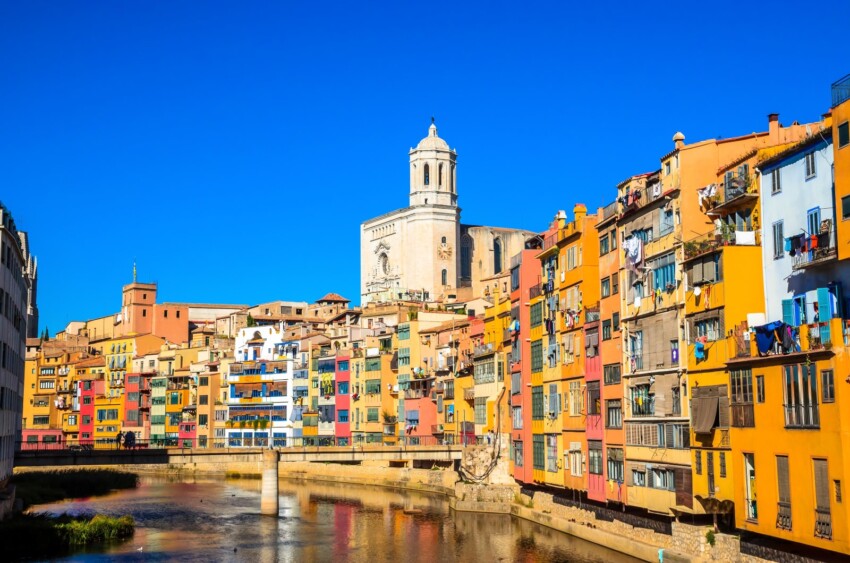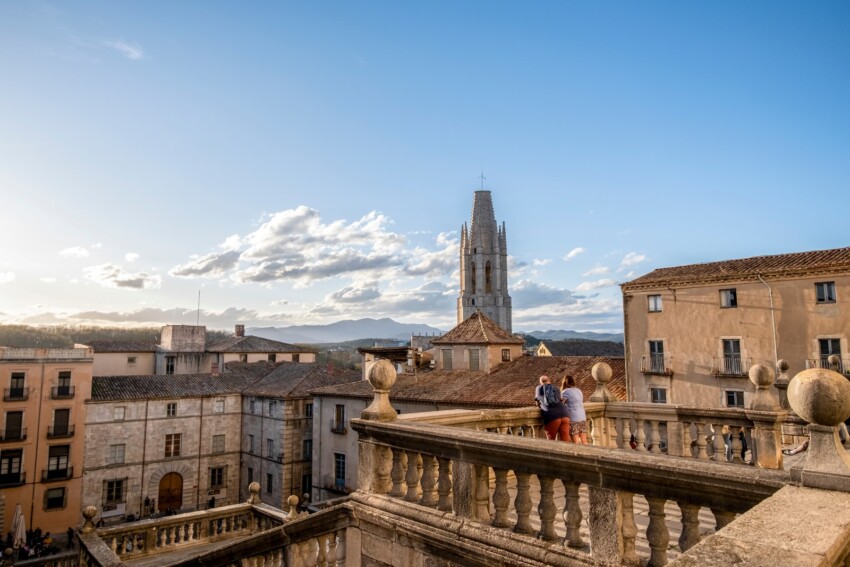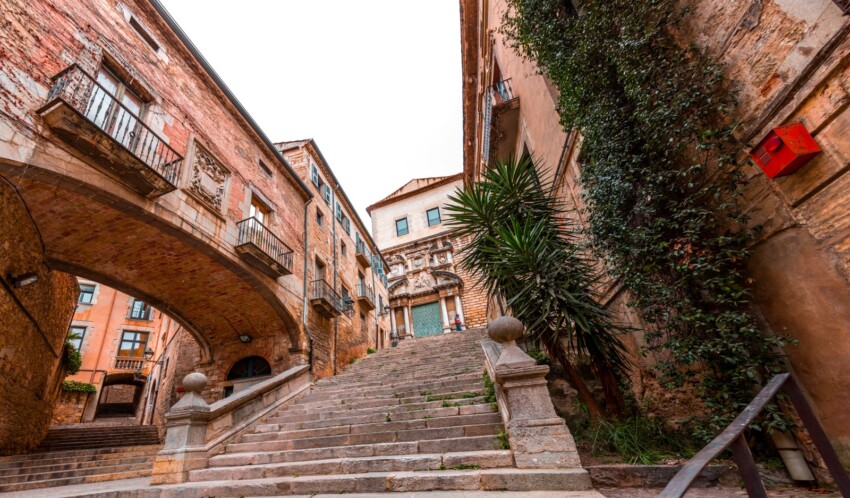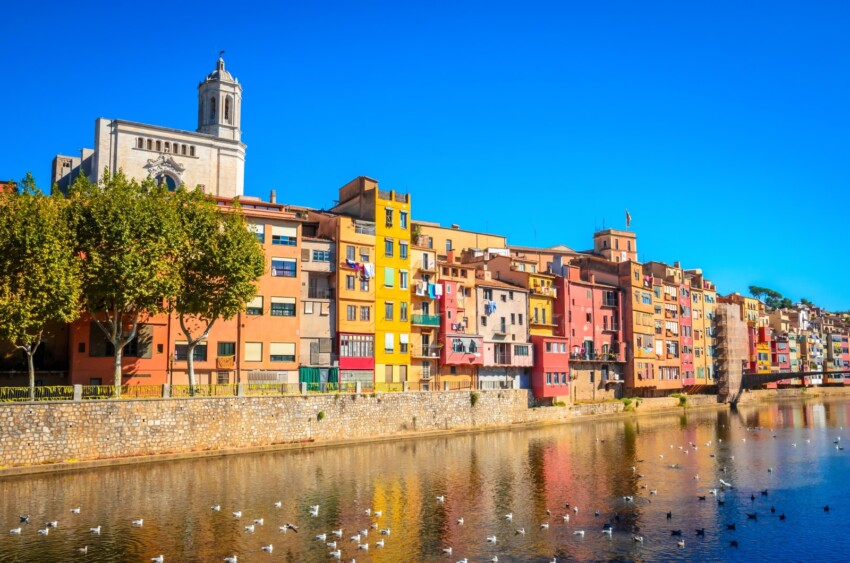

Lying on the banks of the River Onyar, Girona (in Castilian Gerona, although the only official Catalan form is Girona) is one of the most fascinating cities in Catalonia, where millenary history and modernity come together in a perfect blend. Its perfectly preserved medieval walls enclose a historical centre that seems straight out of a fairy tale, with cobbled alleys winding between old colourful houses reflected in the waters of the river.
The city became even more famous after being chosen as the location for scenes from ‘Game of Thrones’, but its charm goes far beyond this recent notoriety. Girona’s atmosphere is a unique mix of Catalan culture and medieval, Jewish and modernist influences. Its inhabitants are proud of their traditions but at the same time open to novelty, as evidenced by the lively gastronomic scene that has made the city a must-visit destination for food lovers.
Girona is a city that lends itself perfectly to being explored on foot, with a historical centre full of architectural and cultural treasures that tell more than two thousand years of history. Every nook and cranny hides a surprise, from the majestic religious monuments to the picturesque squares and museums that hold precious testimonies of the past.

The majestic Girona Cathedral dominates the cityscape with its imposing 91-step staircase, which became even more famous after appearing in the TV series ‘Game of Thrones’. Built between the 11th and 18th centuries, it boasts the widest Gothic nave in the world, at 23 metres wide. The building is a fascinating mix of architectural styles: from Romanesque to Baroque and Gothic.
Inside, the Creation Carpet is a masterpiece of Romanesque art: a 12th-century embroidery depicting scenes from the Creation and the medieval calendar. The Romanesque cloister, with its finely sculpted columns, offers an oasis of peace where one can admire architectural details of rare beauty.

The Call of Girona is considered one of the best preserved medieval Jewish quarters in Europe. For over 600 years, until the expulsion in 1492, this labyrinth of narrow cobbled alleys was the beating heart of the city’s Jewish community. The Centro Bonastruc ça Porta, housed in the former synagogue, now houses the Museum of Jewish History and offers an in-depth insight into the rich cultural heritage of Girona’s Jewish community.
Strolling through the streets of the Call, such as the atmospheric Carrer de la Força, one can admire ancient stone portals, hidden courtyards and medieval staircases that seem frozen in time. The atmosphere is particularly atmospheric in the early morning hours or at sunset, when soft lights create plays of shadows on the stone walls.

The iconic colourful houses reflected in the waters of the Onyar are probably the most photographed image of Girona. These buildings, whose façades are painted in vibrant shades of ochre, pink and yellow, create a spectacular view, particularly striking at sunset when the colours are reflected in the water.
The Pont de Ferro, designed by Gustave Eiffel, offers one of the best vantage points from which to admire this picturesque scenery. The walk along the river allows you to discover ever new views and to understand how the Onyar has shaped the urban development of the city over the centuries.
The ancient medieval walls of Girona, known as ‘Passeig de la Muralla’, offer a scenic walk of almost 3 km around the historical centre. This wall, built between the 9th and 14th centuries, is one of the largest and best-preserved fortified complexes in Europe.
The route along the walls offers a splendid view of the old town, the cathedral and the surrounding mountains. Along the way, one encounters several watchtowers and the Jardines de Alemanys, a green area created within the fortifications that offers a quiet corner in the heart of the historic city.
The Basilica of Sant Feliu, with its characteristic unfinished bell tower, is one of Girona’s most important religious buildings. Built in Gothic style between the 12th and 14th centuries, the church houses important works of art, including a unique collection of Roman and early Christian sarcophagi.
Inside, the Chapel of Sant Narcís, the city’s patron saint, and the medieval frescoes decorating the vaults deserve special attention. The basilica is also an important landmark on the Pilgrim’s Way to Santiago, Girona being a significant stop along the route.
The Monastery of Sant Pere de Galligants is a splendid example of Catalan Romanesque architecture. Now housing the Archaeological Museum of Catalonia, the 12th-century building is striking for its austere beauty and magnificent cloister with richly decorated capitals.
The museum’s collections cover the history of the area from prehistory to the Middle Ages, with a focus on finds from archaeological sites in the region. The Romanesque cloister is considered one of the finest examples of Catalan monastic architecture.
The Rambla de la Llibertat is the beating heart of Girona’s social life. This 19th century arcaded boulevard, lined with historic shops, cafés and restaurants, is the ideal place to soak up the atmosphere of the modern city while admiring the modernist architecture of the surrounding buildings.
At weekends, the Rambla comes alive with flower and antique markets, while its terraces offer the perfect opportunity for a coffee break or an aperitif while watching the lively hustle and bustle of passers-by.
In the following map you can see the location of the main places of interest mentioned in this article.
Barri Vell, the historical centre of Girona, is the most charming area to stay. Here you can breathe in the authentic medieval atmosphere of the city, with all major attractions within walking distance. Boutique hotels in old buildings offer a unique experience, although prices may be higher than in other areas.
The Mercadal district, on the western bank of the Onyar, is a good alternative for those seeking more modern and affordable accommodation. The area is well connected to the city centre and offers a wide choice of restaurants and shops. It is particularly suitable for families due to the presence of spacious flats and amenities.
The area around the railway station is ideal for those seeking convenience and affordability. Hotels here are generally cheaper and the location is strategic for those wishing to use Girona as a base for exploring the Costa Brava or hiking in the surrounding area.
Also consider the Salt area, to the west of the city, but very convenient with respect to infrastructure and the motorway, especially if arriving from the airport in a rental car.
The most obvious solution to get to Girona is to use its airport, popular with low-cost travellers. Unfortunately, however, for some time now Ryanair has been gradually abandoning the airport and settling more and more in Barcelona El Prat, so the options for flying to Girona are no longer what they used to be. If your city does not have a flight to Girona, do not despair: you can easily land in Barcelona and rent a car, or use public transport.
In this case, the alternatives are very varied, but the most efficient choice is the Spanish high-speed train AVE departing from the Barcelona-Sants station, which in just 39 minutes will take you to the Girona station, the only intermediate stop that this train makes, whose final destination is Figueres.
Girona-Costa Brava Airport is located 12 km from the city centre and is mainly served by low-cost airlines. To reach the city centre, there is a shuttle bus service (about 30 minutes’ journey) that operates in connection with flights. Alternatively, taxis take about 20 minutes and cost around €30-35.
Barcelona Airport is about 110 km away and is connected to Girona by frequent bus services and high-speed trains. The AVE train takes only 38 minutes to cover the distance between Barcelona and Girona, with numerous daily runs.
Girona is very well served by the Spanish rail network. High-speed AVE trains connect the city with Barcelona (38 minutes), Madrid (3 hours 30 minutes) and France. The railway station is a few minutes’ walk from the historical centre.
Girona’s privileged location makes it the ideal starting point for exploring some of the most beautiful parts of Catalonia. Renting a car is recommended to get around freely and discover the natural and cultural beauty of the region, from the beaches of the Costa Brava to the picturesque medieval villages of the hinterland.
Just a 40-minute drive from Girona, Figueres is world-famous for being the birthplace of Salvador Dalí and home to the Dalí Theatre-Museum, the world’s largest surrealist work. The museum, designed by the artist himself, is a unique experience that goes beyond the mere display of works of art.
The beautiful beaches and coves of the Costa Brava are less than an hour’s drive away. Places like Tossa de Mar, with its medieval castle high above the sea, or Cadaqués, the charming fishing village beloved by Dalí, are definitely worth a visit.
The medieval village of Besalú, 30 minutes from Girona, is one of the best preserved in Catalonia. Its fortified Romanesque bridge, Romanesque churches and Jewish quarter with its mikveh (ritual bath) form an architectural ensemble of extraordinary value.
What's the weather at Girona? Below are the temperatures and the weather forecast at Girona for the next few days.
Girona is located in the north-eastern part of Catalonia, not far from the French border. It is located slightly inland from the sea, about 15 kilometres from the coast. Compared to Barcelona, Girona is exactly 100 kilometres away.